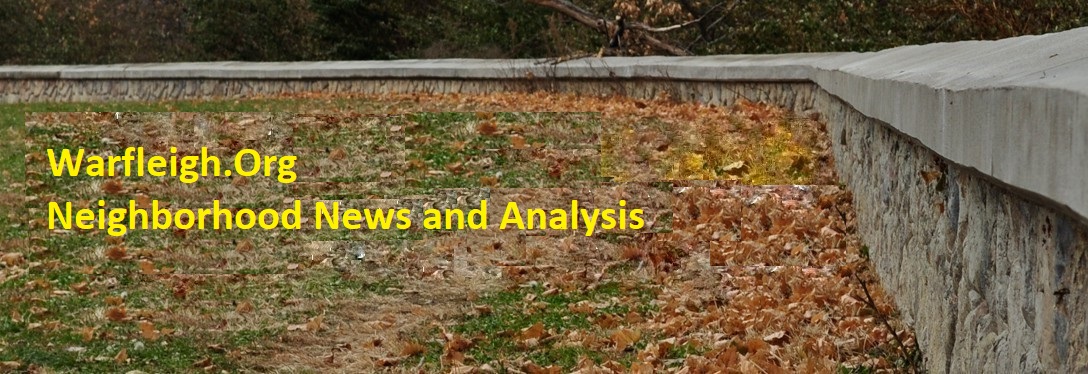Hi all, I hope everyone remains well.
I found out rather by accident the Warfleigh Neighborhood Association (“WNA”) was meeting last night (Tuesday, April 13) to discuss a proposal that could or would restrict the rights of property owners in Warfleigh. You most likely were not aware of the event because the WNA doesn’t widely notice its meetings and doesn’t provide agendas or minutes of such meetings. So, fortunately or unfortunately, here I am. Sigh.
Generally, the WNA contemplates creating an Historic or Conservation District in Warfleigh. Under this plan, the WNA would develop “Zoning and Land Use Recommendations” to govern development and redevelopment in Warfleigh. Any subsequent development or redevelopment would then need to obtain a “Certificate of Appropriateness (COA)” indicating development or redevelopment is consistent with established guidelines and plans. Most likely, the Zoning and Land Use Recommendations would be above and beyond the protections provided by existing zoning laws, code and regulation, otherwise there would be no need for the proposal and plan.
The Zoning and Land Use Recommendations could take various forms. For example, in historic districts, such as Monument Circle or Old Northside, every proposed change to the exterior of a building requires a Certificate of Appropriateness, except those that are specifically exempted by the development plan. This implies a strategy to protect architectural details as well as overall character. Alternatively, in conservation districts, such as Ransom Place or Cumberland, only the proposed changes specified in the plan require a Certificate of Appropriateness and some design guidelines are not as strict as in a historic district. Generally, design guideline categories in historic and conservation districts include the following: (1) demolition; (2) renovating items such as awnings, canopies, doors, porches, roofs and roof elements, trim and ornamentation, windows and window openings; new building requirements and (3) new construction including building heights, setbacks, outlines, orientation, spacing, style and design, parking lots, signage, foundation, materials, etcetera.
Generally, Zoning and Land Use Recommendations as above restrict a homeowner’s property rights and impair a property owner’s economic freedom to use their property in a manner consistent with existing law, code and regulation and naturally raises fundamental questions:
Should we be concerned?
Yes and no.
Completing the floodwall and levee project may trigger a wave of development and redevelopment in Warfleigh. Some neighbors may find certain development and redevelopment projects desirable. Others may find the same redevelopment projects undesirable. Nevertheless, in both cases Warfleigh residents have the opportunity to either oppose or support development and redevelopment projects by participating in the public hearing and comment process provided by current law, code and regulation.
More fundamentally, the WNA’s long standing lack of transparency is an issue it must address. Generally, any time the WNA meets to discuss public affairs and policy issues that affect Warfleigh residents – and especially their property rights – at a minimum it must widely notice such meetings, make agendas available for such meetings and provide minutes for such meetings. The WNA’s willingness to meet and discuss such matters without notice, agenda and minutes is both alarming and chilling. The WNA suggests it should be excused or forgiven for this lack of transparency because it is fledgling volunteer organization that struggles with resources. And indeed that is true. Nevertheless, if the WNA cannot even fulfill basic functions regarding transparency and openness because it is a fledgling, volunteer organization, then the WNA certainly should not volunteer to act on my behalf (and without my notice) on a controversial public policy proposal that would restrict property rights.
Alternatively, the WNA’s inability to perform basic functions also suggests this initiative likely may fail. The initiative requires strong transparency, a proposed methodology to seek and measure support, outreach, educational workshops, cataloguing and describing Warfleigh neighborhood assets and a statement of their significance, and the development of land use, zoning and design guidelines, among others. If the WNA struggles to maintain a website and mailing list and post meetings notices, agendas, and minutes, then it may be likely it does not have the capacity to complete the tasks highlighted above.
Is there an easier, less controversial path forward?
Indeed. The WNA should continue to build its capacity and form a “land use committee.” This committee would familiarize itself with all pertinent zoning and land use regulation including the Envision Broad Ripple Plan. Then, on a case-by-case basis, stakeholders affected by development or redevelopment could ask the land use committee for guidance and support. This support could include filing written comments and participating in public hearings. Then, over time, if the committee gains stature and respect, it may be a vehicle through which individuals share development and redevelopment plans in advance, seeking comment, guidance and feedback.
Thanks all. Again, I share this note because otherwise many of you might not know of developments that may affect your rights, liberty, and pursuit of economic freedom (America the Beautiful plays in the background!) Please reach out with any questions, comments, and concerns. I would LOVE to hear what you think as I continue neighborhood advocacy.
Jim Polito
